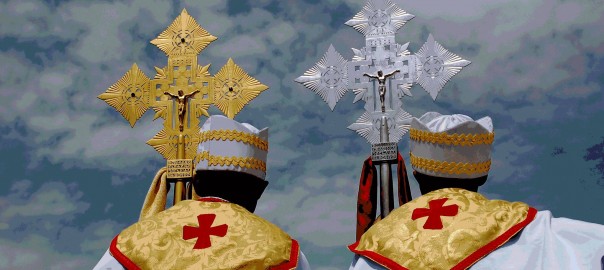What is a sacrament?
A Sacrament, in a very broad sense of the term, combines two elements: one visible, the other invisible – one can be seen, or tasted, or touched, or heard while the other remains unseen to the eyes of the flesh. There is, however, a relation or significance between the two.
For example, a spoken word is a kind of sacrament because there is something material or audible about it; there is also something spiritual about it, namely, its meaning. A horse can hear a funny story just as well as a man. It is conceivable that the horse may even hear the words better than the man and at the end of the story the man may laugh, but the horse will never give a horselaugh. The reason is that the horse gets the material side of the ‘sacrament’ namely the sound, but man gets the invisible or the spiritual side, namely, the meaning.
Take the brazen serpent in the desert. When the Jewish people were bitten by poisonous serpents, God commanded Moses to make a brazen serpent, and to hang it over the crotch of a tree (Num 21:8-9); all who would look upon that serpent of brass would be healed of the serpent’s sting. This apparently was a rather ridiculous remedy for poison and not everyone looked at it. If one could discern or guess their reason, it would probably be because they concentrated on only one side of the symbol, namely, the shinny, lifeless brass thing hanging on a pole. But it proved to be a symbol of faith; God used that material thing as a symbol of trust or faith in Him. The symbolism goes still further, the Old Testament is fulfilled in our Lord Jesus Christ who revealed the full mystery of the brazen serpent. Our Lord told Nicodemus that the brass serpent was lifted up in the desert so that He would have to be lifted up on the cross (Jn 3:14). The meaning now becomes clear; the brass serpent in the desert looked like the serpent that bit the people, but though it seemed to be the same, it was actually without any poison. Our Blessed Lord now says that He is like that brazen serpent. He, too, would be lifted up on the crotch of a tree, a cross. He would look as if He Himself was filled with the poison of sin, for His body would bear the marks, and the stings, and the piercing of sin; and yet as the brass serpent was without poison so He would be without sin. As those who looked upon that brass serpent in the desert in faith were healed of the bite of the serpent, so all who would look upon Him on His cross bearing the sins and poisons of the world would also be healed of the poison of the serpent, Satan.
Every Sacrament has an outward or visible sign. For example, in Baptism it is water, in the Eucharist it is bread and wine, but the Sacrament also has a form or formula, words of spiritual significance given to the matter when it is conferred. Three things then are absolutely required for a Sacrament: (1) Its institution by the Lord Jesus Christ, (2) an outward sign, (3) the power of conferring the grace purchased for us by the Passion, Death, and Resurrection of the Lord.
The Ethiopian Orthodox Tewahedo Church serves the faithful through the seven sacraments. These sacraments are called mysteries because the invisible grace of the Holy Spirit is granted through them. The Ethiopian Orthodox Tewahedo Church, taking the example of pillars as has been said in the Proverbs of Solomon as a starting point, teaches that there are seven sacraments (Proverbs 9:1). Of the seven, the six sacraments can be performed by a bishop and a priest. Ordination is the only sacrament which can be performed by a bishop only.
The seven sacraments are:

